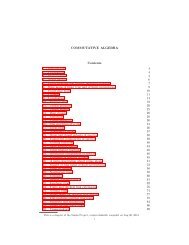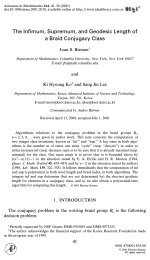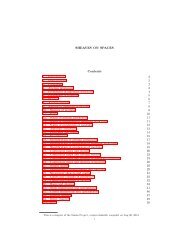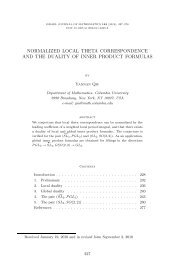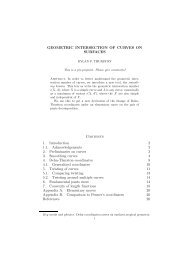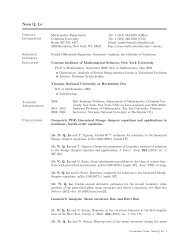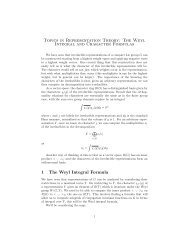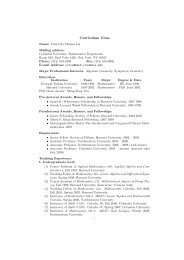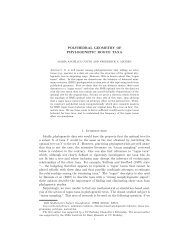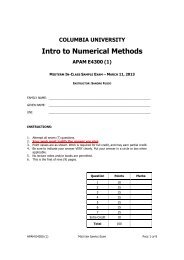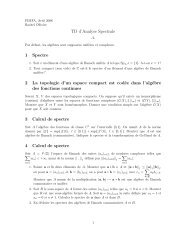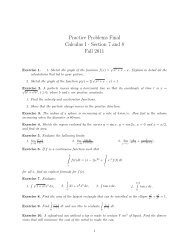pdf file - Department of Mathematics - Columbia University
pdf file - Department of Mathematics - Columbia University
pdf file - Department of Mathematics - Columbia University
You also want an ePaper? Increase the reach of your titles
YUMPU automatically turns print PDFs into web optimized ePapers that Google loves.
Pacific<br />
Journal <strong>of</strong><br />
<strong>Mathematics</strong><br />
REMARKS ON THE CURVATURE BEHAVIOR<br />
AT THE FIRST SINGULAR TIME OF THE RICCI FLOW<br />
NAM Q. LE AND NATASA SESUM<br />
Volume 255 No. 1 January 2012
PACIFIC JOURNAL OF MATHEMATICS<br />
Vol. 255, No. 1, 2012<br />
REMARKS ON THE CURVATURE BEHAVIOR<br />
AT THE FIRST SINGULAR TIME OF THE RICCI FLOW<br />
NAM Q. LE AND NATASA SESUM<br />
We study the curvature behavior at the first singular time <strong>of</strong> a solution to<br />
the Ricci flow<br />
∂<br />
∂ t gi j = −2Ri j, t ∈ [0, T),<br />
on a smooth, compact n-dimensional Riemannian manifold M. If the flow<br />
has uniformly bounded scalar curvature and develops Type I singularities<br />
at T, we show that suitable blow-ups <strong>of</strong> the evolving metrics converge in<br />
the pointed Cheeger–Gromov sense to a Gaussian shrinker by using Perelman’s<br />
-functional. If the flow has uniformly bounded scalar curvature<br />
and develops Type II singularities at T, we show that suitable scalings <strong>of</strong> the<br />
potential functions in Perelman’s entropy functional converge to a positive<br />
constant on a complete, Ricci flat manifold. We also show that if the scalar<br />
curvature is uniformly bounded along the flow in certain integral sense then<br />
the flow either develops a Type II singularity at T or it can be smoothly<br />
extended past time T.<br />
1. Introduction<br />
The Ricci flow and previous results. Let M be a smooth, compact n-dimensional<br />
Riemannian manifold without boundary equipped with a smooth Riemannian metric<br />
g0, where n ≥ 3. Let g(t), 0 ≤ t < T , be a one-parameter family <strong>of</strong> metrics<br />
on M. The Ricci flow equation on M with initial metric g0<br />
∂<br />
(1-1)<br />
g(t) = −2 Ric(g(t)), g(0) = g0.<br />
∂t<br />
was introduced in the seminal paper [Hamilton 1982]. It is a weakly parabolic<br />
system <strong>of</strong> equations whose short-time existence was proved by Hamilton using the<br />
Nash–Moser implicit function theorem in the same paper and after that simplified<br />
by DeTurck [1983]. The goal in the analysis <strong>of</strong> (1-1) is to understand the long-time<br />
behavior <strong>of</strong> the flow and possible singularity formation or convergence <strong>of</strong> the flow<br />
in the cases when we do have a long-time existence. In general, the behavior <strong>of</strong><br />
the flow can give insight into the topology <strong>of</strong> the underlying manifold. One <strong>of</strong> the<br />
Sesum was partially supported by NSF grant 0905749.<br />
MSC2010: primary 53C44; secondary 35K10.<br />
Keywords: Ricci flow, scalar curvature, evolution.<br />
155
156 NAM Q. LE AND NATASA SESUM<br />
great successes is the resolution <strong>of</strong> the Poincaré conjecture by Perelman. In order to<br />
discuss the long-time behavior we have to understand what happens at the singular<br />
time and also what the optimal conditions for having a smooth solution are.<br />
Hamilton [1995b] showed that if the norm <strong>of</strong> Riemannian curvature |Rm|(g(t))<br />
stays uniformly bounded in time for all t ∈ [0, T ) with T < ∞, then we can extend<br />
the flow (1-1) smoothly past time T . In other words, either the flow exists forever<br />
or the norm <strong>of</strong> Riemannian curvature blows up in finite time. Wang [2008] and Ye<br />
[2008] extended this result, assuming certain integral bounds on the Riemannian<br />
curvature. Namely, if<br />
T<br />
0<br />
<br />
M<br />
|Rm| α dvolg(t) dt ≤ C for some α ≥ n+2<br />
2 ,<br />
then the flow can be extended smoothly past time T . Throughout the paper, dvolg<br />
denotes the Riemannian volume density on (M, g). On the other hand, Sesum<br />
[2005] improved Hamilton’s extension result and showed if the norm <strong>of</strong> Ricci curvature<br />
is uniformly bounded over a finite time interval [0, T ), then we can extend<br />
the flow smoothly past time T . Wang [2008] improved this even further, showing<br />
that if Ricci curvature is uniformly bounded from below and if the space-time<br />
integral <strong>of</strong> the scalar curvature is bounded, say<br />
T<br />
0<br />
<br />
M<br />
|R| α dvolg(t) dt ≤ C for α ≥ n+2<br />
2 ,<br />
where R is the scalar curvature, then we can extend the flow smoothly past time T .<br />
The requirement on Ricci curvature in [Wang 2008] is rather restrictive. Ricci flow<br />
does not in general preserve nonnegative Ricci curvature in dimensions n ≥ 4. See<br />
[Knopf 2006] for noncompact examples starting in dimension n = 4 and [Böhm<br />
and Wilking 2007] for compact examples starting in dimension n = 12. Recently,<br />
Maximo [2011] brought the result <strong>of</strong> [Böhm and Wilking 2007] down to dimension<br />
4 by showing that nonnegative Ricci curvature is not preserved under Ricci<br />
flow for closed compact manifolds <strong>of</strong> dimensions 4 and above. Without assuming<br />
the boundedness from below <strong>of</strong> Ricci curvature, Ma and Cheng [2010] proved that<br />
the norm <strong>of</strong> Riemannian curvature can be controlled given integral bounds on the<br />
scalar curvature R and the Weyl tensor W from the orthogonal decomposition <strong>of</strong><br />
the Riemannian curvature tensor. Their bounds are <strong>of</strong> the form<br />
T<br />
0<br />
<br />
(|R|<br />
M<br />
α + |W | α ) dvolg(t) dt ≤ C for α ≥ n+2<br />
2 .<br />
This is not surprising since Knopf [2009] has shown that the trace-free Ricci tensor<br />
is controlled pointwise by the scalar curvature and the Weyl tensor without any<br />
additional hypotheses. Zhang [2010] proved that the scalar curvature controls the<br />
Kähler Ricci flow ∂<br />
∂t gi ¯j = −Ri ¯j − gi ¯j starting from any Kähler metric g0.
CURVATURE BEHAVIOR AT THE FIRST SINGULAR TIME OF THE RICCI FLOW 157<br />
Main results. The above results, in particular that <strong>of</strong> [Zhang 2010], support the<br />
belief that the scalar curvature should control the Ricci flow in the Riemannian<br />
setting as well. Enders, Müller and Topping [2010] justified this belief for Type I<br />
Ricci flow:<br />
Theorem 1.1 [Enders et al. 2010]. Let M be a smooth, compact n-dimensional<br />
Riemannian manifold equipped with a smooth Riemannian metric g0 and g( · , t)<br />
be a solution to the Type I Ricci flow (1-1) on M. Assume there is a constant C so<br />
that sup M |R( · , t)| ≤ C for all t ∈ [0, T ) and T < ∞. Then we can extend the flow<br />
past time T .<br />
Their pro<strong>of</strong> was based on a blow-up argument using Perelman’s reduced distance<br />
and pseudolocality theorem.<br />
Assume the flow (1-1) develops a singularity at T < ∞.<br />
Definition 1.1. We say that (1-1) has a Type I singularity at T if there exists a<br />
constant C > 0 such that for all t ∈ [0, T )<br />
(1-2) max<br />
M |Rm( · , t)| · (T − t) ≤ C.<br />
Otherwise we say the flow develops Type II singularity at T . Moreover, the flow<br />
that satisfies (1-2) will be referred to as to the Type I Ricci flow.<br />
In this paper, we also use a blow-up argument to study curvature behavior at the<br />
first singular time <strong>of</strong> the Ricci flow. We deal with both Type I and II singularities.<br />
Assume that the scalar curvature is uniformly bounded along the flow. If the flow<br />
develops Type I singularities at some finite time T then by using Perelman’s entropy<br />
functional , we show that suitable blow-ups <strong>of</strong> the evolving metrics converge in<br />
the pointed Cheeger–Gromov sense to a Gaussian shrinker.<br />
Theorem 1.2. Let M be a smooth, compact n-dimensional Riemannian manifold<br />
(n ≥ 3) and g( · , t) be a solution to the Ricci flow (1-1) on M. Assume there is a<br />
constant C so that sup M |R( · , t)| ≤ C for all t ∈ [0, T ) and T < ∞. Assume that<br />
at T we have a Type I singularity and the norm <strong>of</strong> the curvature operator blows up.<br />
Then by suitably rescaling the metrics, we get a Gaussian shrinker in the limit.<br />
A simple consequence <strong>of</strong> the pro<strong>of</strong> <strong>of</strong> Theorem 1.2 is following result, which is<br />
also proved in [Naber 2010]. Instead <strong>of</strong> the reduced distance techniques used by<br />
Naber, we use Perelman’s monotone functional .<br />
Corollary 1.1. Let M be a smooth, compact n-dimensional Riemannian manifold<br />
(n ≥ 3) and g( · , t) be a solution to the Ricci flow (1-1) on M. If the flow has<br />
a Type I singularity at T , then a suitable rescaling <strong>of</strong> the solution converges to a<br />
gradient shrinking Ricci soliton.
158 NAM Q. LE AND NATASA SESUM<br />
Naber [2010] proved that in the case <strong>of</strong> a Type I singularity, a suitable rescaling<br />
<strong>of</strong> the flow converges to gradient shrinking Ricci soliton. Enders, Müller and Topping<br />
[2010] recently showed that the limiting soliton represents a singularity model,<br />
that is, it is nonflat (see also [Cao and Zhang 2011]). The open question is whether<br />
using Perelman’s -functional, one can produce in the limit a singularity model<br />
(nonflat gradient shrinking Ricci solitons). We prove some interesting estimates on<br />
the minimizers <strong>of</strong> Perelman’s -functional which could be <strong>of</strong> independent interest.<br />
On the other hand, if the flow develops Type II singularities at some finite time T ,<br />
then we show that suitable scalings <strong>of</strong> the potential functions in Perelman’s entropy<br />
functional converge to a positive constant on a complete, Ricci flat manifold which<br />
is the pointed Cheeger–Gromov limit <strong>of</strong> a suitably chosen sequence <strong>of</strong> blow-ups<br />
<strong>of</strong> the original evolving metrics.<br />
Theorem 1.3. Let M be a smooth, compact n-dimensional Riemannian manifold<br />
(n ≥ 3) and g( · , t) be a solution to the Ricci flow (1-1) on M. Assume there is<br />
a constant C so that sup M |R( · , t)| ≤ C for all t ∈ [0, T ) and T < ∞. Assume<br />
that at T we have a Type II singularity and the norm <strong>of</strong> the curvature operator<br />
blows up. Let φi be as in the pro<strong>of</strong> <strong>of</strong> Theorem 1.2 (see, for example, (3-9)). Then<br />
by suitably rescaling the metrics and φi, we get as a limit <strong>of</strong> φi a positive constant<br />
on a complete, Ricci flat manifold.<br />
We believe that Theorem 1.3 may play a role in proving the nonexistence <strong>of</strong><br />
Type II singularities if the scalar curvature is uniformly bounded along the flow.<br />
We are still investigating this issue.<br />
For a precise definition <strong>of</strong> φi, see Section 3.<br />
There has been a striking analogy between the Ricci flow and the mean curvature<br />
flow for decades now. Around the same time Hamilton proved that the norm <strong>of</strong><br />
the Riemannian curvature under the Ricci flow must blow up at a finite singular<br />
time, Huisken [1984] showed that the norm <strong>of</strong> the second fundamental form <strong>of</strong><br />
an evolving hypersurface under the mean curvature flow must blow up at a finite<br />
singular time. The analogue <strong>of</strong> Wang’s result holds for the mean curvature flow as<br />
well [Le and Sesum 2011], namely if the second fundamental form <strong>of</strong> an evolving<br />
hypersurface is uniformly bounded from below and if the mean curvature is<br />
bounded in a certain integral sense, then we can smoothly extend the flow. In the<br />
follow-up paper [Le and Sesum 2010] the authors show that given only the uniform<br />
bound on the mean curvature <strong>of</strong> the evolving hypersurface, the flow either develops<br />
a Type II singularity or can be smoothly extended. In the case the dimension <strong>of</strong><br />
the evolving hypersurfaces is 2 they show that under some density assumptions<br />
one can smoothly extend the flow provided that the mean curvature is uniformly<br />
bounded. Finally, in contrast to the lower bound on the scalar curvature (2-3), at<br />
the first singular time <strong>of</strong> the mean curvature flow, the mean curvature can either
CURVATURE BEHAVIOR AT THE FIRST SINGULAR TIME OF THE RICCI FLOW 159<br />
tend to ∞ (as in the case <strong>of</strong> a round sphere) or −∞ as in some examples <strong>of</strong> Type II<br />
singularities [Angenent and Velázquez 1997].<br />
If we replace the pointwise scalar curvature bound in Theorem 1.1 with an integral<br />
bound, we can prove the following theorems.<br />
Theorem 1.4. If g( · , t) solves (1-1) and if<br />
<br />
(1-3)<br />
|R|<br />
M<br />
α (t) dvolg(t) ≤ Cα<br />
for all t ∈ [0, T ) where α > n/2 and T < ∞, then either the flow develops a Type II<br />
singularity at T or the flow can be smoothly extended past time T .<br />
Remark 1.1. The condition on α in Theorem 1.4 is optimal. Let (Sn , g0) be the<br />
space form <strong>of</strong> constant sectional curvature 1. The Ricci flow on M = Sn with initial<br />
metric g0 has the solution g(t) = (1 − 2(n − 1)t)g0. Therefore T = 1/(2(n − 1))<br />
is the maximal existence time. Rewrite g(t) = 2(n − 1)(T − t)g0 to compute<br />
<br />
|R|<br />
M<br />
α <br />
n α<br />
(t) dvolg(t) = volg(t)(M)<br />
2(T −t)<br />
= volg(0)(M)(2(n − 1)(T − t)) n/2<br />
<br />
n α<br />
2(T −t)<br />
= volg(0)(M)2 n/2−α (n − 1) n/2 n α 1<br />
.<br />
(T −t) α−n/2<br />
Hence <br />
M |R|α (t) dvolg(t) tends to ∞ as t → T if and only if α > n/2.<br />
Theorem 1.5. If g( · , t) solves (1-1) and if we have the space-time integral bound<br />
T <br />
(1-4)<br />
0<br />
|R|<br />
M<br />
α (t) dvolg(t) dt ≤ Cα<br />
for α ≥ (n + 2)/2, then the flow either develops a Type II singularity at T or can<br />
be smoothly extended past time T .<br />
Remark 1.2. The condition on α in Theorem 1.5 is optimal. As in Remark 1.1 consider<br />
the Ricci flow on the round sphere. Following the computation in Remark 1.1<br />
we get<br />
T<br />
0<br />
<br />
M<br />
|R| α dvolg(t) dt = volg(0)(M)2 n/2−α (n − 1) n/2 n α<br />
and therefore the integral is ∞ if and only if α ≥ (n + 2)/2.<br />
T<br />
0<br />
1<br />
dt,<br />
(T −t) α−n/2<br />
For the mean curvature flow, a similar result to Theorem 1.5 has been obtained<br />
in [Le and Sesum 2010].<br />
The rest <strong>of</strong> the paper is organized as follows. In Section 2 we give some necessary<br />
preliminaries. Section 3 is devoted to the statements and pro<strong>of</strong>s <strong>of</strong> Theorems<br />
1.2 and 1.3. In Section 4 we prove Theorems 1.4 and 1.5.
160 NAM Q. LE AND NATASA SESUM<br />
2. Preliminaries<br />
In this section, we recall basic evolution equations during the Ricci flow and<br />
the definition <strong>of</strong> singularity formation. Then we recall Perelman’s entropy functional<br />
and in Lemma 2.1 prove one <strong>of</strong> its properties, nonpositivity <strong>of</strong> the µenergy.<br />
The nonpositivity <strong>of</strong> the µ-energy turns out to be very crucial for the pro<strong>of</strong><br />
<strong>of</strong> Theorem 1.1.<br />
Evolution equations and singularity formation. Consider the Ricci flow (1-1) on<br />
[0, T ). Then, the scalar curvature R and the volume form volg(t) evolve by<br />
(2-1)<br />
(2-2)<br />
∂<br />
∂t R = R + 2|Ric|2 ,<br />
∂<br />
∂t volg(t) = −R volg(t) .<br />
Because |Ric| 2 ≥ R 2 /n, the maximum principle applied to (2-1) yields<br />
(2-3) R(g(t)) ≥<br />
minM R(g(0))<br />
1 − (2 minM R(g(0))t)/n .<br />
If T < +∞ and the norm <strong>of</strong> the Riemannian curvature |Rm|(g(t)) becomes unbounded<br />
as t tends to T , we say the Ricci flow develops singularities as t tends to T<br />
and T is a singular time. It is well-known that the Ricci flow generally develops<br />
singularities.<br />
If a solution (M, g(t)) to the Ricci flow develops singularities at T < +∞, then<br />
according to [Hamilton 1995b], we say that it develops a Type I singularity if<br />
and it develops a Type II singularity if<br />
sup (T − t) max |Rm( · , t)| < +∞,<br />
t∈[0,T )<br />
M<br />
sup (T − t) max |Rm( · , t)| = +∞.<br />
t∈[0,T )<br />
M<br />
Clearly, the Ricci flow <strong>of</strong> a round sphere develops a Type I singularity in finite<br />
time. The existence <strong>of</strong> Type II singularities for the Ricci flow has been recently<br />
established in [Gu and Zhu 2008], proving the degenerate neckpinch conjecture <strong>of</strong><br />
[Hamilton 1995b].<br />
Finally, by the curvature gap estimate for Ricci flow solutions with a finite-time<br />
singularity (see, for example, [Chow et al. 2006, Lemma 8.7]), we have<br />
1<br />
(2-4) max |Rm(x, t)| ≥<br />
x∈M 8(T −t) .
CURVATURE BEHAVIOR AT THE FIRST SINGULAR TIME OF THE RICCI FLOW 161<br />
Perelman’s entropy functional and the µ-energy. Perelman [2002] introduced<br />
a very important functional, the entropy functional , for the study <strong>of</strong> the Ricci<br />
flow:<br />
(2-5) (g, f, τ) = (4πτ) −n/2<br />
<br />
2 − f<br />
τ(R + |∇ f | ) + f − n e dvolg,<br />
M<br />
under the constraint (4πτ) −n/2<br />
M e− f dvolg = 1. The functional is invariant<br />
under the parabolic scaling <strong>of</strong> the Ricci flow and invariant under diffeomorphism.<br />
Namely, for any positive number α and any diffeomorphism ϕ, we have<br />
(αϕ∗g, ϕ∗ f, ατ) = (g, f, τ). Perelman showed that if ˙τ = −1 and f ( · , t) is<br />
a solution to the backwards heat equation<br />
(2-6)<br />
∂ f<br />
∂t = −f + |∇ f |2 − R + n<br />
2τ ,<br />
and if g( · , t) solves the Ricci flow (1-1) then<br />
<br />
d<br />
<br />
(g(t), f (t), τ) = (2τ) · (4πτ)−n/2 <br />
dt Ri j + ∇i∇j f − gi<br />
<br />
j 2<br />
<br />
2τ e − f dvolg(t) ≥ 0.<br />
The functional is constant on metrics g with the property that<br />
M<br />
Ri j + ∇i∇j f − gi j<br />
2τ<br />
for a smooth function f . These metrics are called gradient shrinking Ricci solitons<br />
and appear <strong>of</strong>ten as singularity models, that is, limits <strong>of</strong> blown up solutions around<br />
finite-time singularities <strong>of</strong> the Ricci flow.<br />
Let g(t) be a solution to the Ricci flow (1-1) on (−∞, T ). We call a triple<br />
(M, g(t), f (t)) on (−∞, T ) with smooth functions f : M → a gradient shrinking<br />
soliton in canonical form if it satisfies<br />
= 0<br />
(2-7) Ric(g(t))+∇ g(t) ∇ g(t) 1<br />
f (t)− g(t) = 0 and<br />
2(T −t)<br />
Perelman also defines the µ-energy<br />
∂<br />
∂t f (t) = | f (t)|2 g(t) .<br />
(2-8) µ(g, τ) = inf (g, f, τ) over <br />
f | (4πτ) −n/2<br />
M e− f dvolg = 1 <br />
and shows that<br />
(2-9) d<br />
µ(g( · , t), τ) ≥ (2τ)·(4πτ)−n/2<br />
dt<br />
<br />
M<br />
<br />
<br />
<br />
Ri j +∇i∇j − gi<br />
<br />
j 2<br />
<br />
2τ e − f dvolg(t) ≥ 0,<br />
where f ( · , t) is the minimizer for (g( · , t), f, τ) with the constraint on f as<br />
in (2-8). The µ-energy µ(g, τ) corresponds to the best constant <strong>of</strong> a logarithmic<br />
Sobolev inequality. Adjusting some <strong>of</strong> Perelman’s arguments to our situation we<br />
get the following lemma whose pro<strong>of</strong> we include for the reader’s convenience.
162 NAM Q. LE AND NATASA SESUM<br />
Lemma 2.1 (nonpositivity <strong>of</strong> the µ-energy). If g(t) is a solution to (1-1) for all<br />
t ∈ [0, T ), then µ(g(t), T − t) ≤ 0 for all t ∈ [0, T ).<br />
Pro<strong>of</strong>. We are assuming the Ricci flow exists for all t ∈ [0, T ). Fix t ∈ [0, T ).<br />
Define ˜g(s) = g(t + s) for s ∈ [0, T − t). Pick any ¯τ < T − t. Let τ0 = ¯τ − ε with<br />
ε > 0 small. Pick p ∈ M. We use normal coordinates about p on (M, ˜g(τ0)) to<br />
define<br />
<br />
|x| 2 /4ε if d ˜g(τ0)(x, x0) < ρ0,<br />
(2-10) f1(x) =<br />
ρ2 0 /4ε elsewhere,<br />
where ρ0 > 0 is smaller than the injectivity radius. Note that dvol ˜g(τ0)(x) =<br />
1 + O(|x| 2 ) near p. We compute<br />
<br />
(4πε)<br />
M<br />
−n/2 e − f1 dvol ˜g(τ0)<br />
<br />
=<br />
<br />
=<br />
|x|≤ρ0<br />
|y|≤ρ0/ √ ε<br />
(4πε) −n/2 e −|x|2 /4ε (1 + O(|x| 2 )) dx + O(ε −n/2 e −ρ 2 0 /4ε )<br />
(4π) −n/2 e −|y|2 /4 (1 + O(ε|y| 2 )) dy + O(ε −n/2 e −ρ 2 0 /4ε ).<br />
The second term goes to zero as ε → 0 while the first term converges to<br />
<br />
(4π) −n/2 e −|y|2 /4<br />
dy = 1.<br />
n<br />
Writing the integral as eC , then C → 0 as ε → 0. And f = f1 + C then satisfies<br />
the constraint <br />
M (4πε)−n/2e− f dvol ˜g(τ0) = 1.<br />
Solve Equation (2-6) backwards with initial value f at τ0. Then<br />
( ˜g(τ0), f (τ0), ¯τ − τ0)<br />
<br />
|x| 2 <br />
= ε +R +<br />
|x|≤ρ0 4ε2 |x|2<br />
4ε +C−n<br />
<br />
(4πε) −n/2 e −|x|2 /4ε−C 2<br />
(1+O(|x| )) dx<br />
<br />
ρ2 <br />
o<br />
+<br />
+ εR + C − n (4πε)<br />
M−B(p,ρ0) 4ε −n/2 e −r 2 0 /4ε−C<br />
= I + II,<br />
<br />
where I = e−C |x|≤ρ0 (|x|2 /2ε − n)(4πε) −n/2e−|x|2 /4ε (1 + O(|x| 2 )) dx and II contains<br />
all the remaining terms. It is obvious that II → 0 as ε → 0 while<br />
I = e −C<br />
<br />
|y| 2 <br />
− n (4π)<br />
2 −n/2 e −|y|2 /4 2<br />
(1 + O(ε|y| )) dy<br />
|y|≤ρ0/ √ ε<br />
<br />
→<br />
n <br />
|y| 2 <br />
− n (4π)<br />
2 −n/2 e −|y|2 /4<br />
dy = 0 as ε → 0.
CURVATURE BEHAVIOR AT THE FIRST SINGULAR TIME OF THE RICCI FLOW 163<br />
Therefore ( ˜g(τ0), f (τ0), ¯τ −τ0) → 0 as τ0 → ¯τ. By the monotonicity <strong>of</strong> µ along<br />
the flow, µ(g(t), ¯τ) = µ( ˜g(0), ¯τ) ≤ ( ˜g(0), f (0), ¯τ) ≤ ( ˜g(τ0), f (τ0), ¯τ − τ0).<br />
Letting τ0 → ¯τ, we get µ(g(t), ¯τ) ≤ 0. Since ¯τ < T − t is arbitrary,<br />
µ(g(t), T − t) ≤ 0. <br />
3. Uniform bound on scalar curvature<br />
In this section, we prove Theorems 1.2 and 1.3.<br />
Pro<strong>of</strong> <strong>of</strong> Theorem 1.2. By our assumptions, there exists a sequence <strong>of</strong> times ti → T<br />
so that Qi := maxM×[0,ti ] |Rm|(x, t) → ∞ as i → ∞. Assume that the maximum<br />
is achieved at (pi, ti) ∈ M × [0, ti]. Define a rescaled sequence <strong>of</strong> solutions<br />
(3-1) gi(t) = Qi · g(ti + t/Qi).<br />
We have that<br />
(3-2) |Rm(gi)| ≤ 1 on M × [−ti Qi, 0] and |Rm(gi)|(pi, 0) = 1.<br />
By Hamilton’s compactness theorem [1995a] and Perelman’s κ-noncollapsing theorem<br />
[2002] we can extract a pointed subsequence <strong>of</strong> solutions (M, gi(t), qi), converging<br />
in the Cheeger–Gromov sense to a solution to (1-1), which we denote by<br />
(M∞, g∞(t), q∞) for any sequence <strong>of</strong> points qi ∈ M. In particular, if we take<br />
that sequence <strong>of</strong> points to be exactly {pi}, we can guarantee the limiting metric is<br />
nonflat. The limiting metric has a sequence <strong>of</strong> nice properties: Since<br />
|R(gi(t))| = |R(g(ti + t/Qi))|<br />
Qi<br />
≤ C<br />
Qi<br />
→ 0,<br />
the limiting solution (M∞, g∞(t)) is scalar flat for each t ∈ (−∞, 0]. Since it<br />
solves the Ricci flow (1-1) and R∞ := R(g∞) evolves by<br />
∂<br />
∂t R∞ = R∞ + 2| Ric(g∞)| 2 ,<br />
we have that Ric(g∞) ≡ 0, that is, the limiting metric is Ricci flat. We will get a<br />
Gaussian shrinker by using Perelman’s functional µ defined by (2-8). Recall that<br />
(see the computation in [Kleiner and Lott 2008])<br />
<br />
d<br />
µ(g(t), τ) ≥ 2τ · (4πτ)−n/2<br />
dt<br />
M<br />
<br />
<br />
<br />
<br />
g <br />
Ric +∇∇ f − <br />
2τ <br />
2<br />
e − f dvolg(t),<br />
where f ( · , t) is the minimizer realizing µ(g(t), τ), and τ = T − t.<br />
In this pro<strong>of</strong> <strong>of</strong> Theorem 1.2, we take s, v ∈ [−10, 0] with s < v. Then, by (3-2),<br />
gi(s) and gi(v) are defined for i sufficiently large. Then, by the invariant property
164 NAM Q. LE AND NATASA SESUM<br />
<strong>of</strong> µ under the parabolic scaling <strong>of</strong> the Ricci flow, for s < v ∈ [−10, 0] one has<br />
(3-3) µ(gi(v), Qi(T − ti) − v) − µ(gi(s), Qi(T − ti) − s)<br />
<br />
= µ g ti + v<br />
<br />
, T − ti −<br />
Qi<br />
v<br />
<br />
− µ g ti +<br />
Qi<br />
s<br />
<br />
, T − ti −<br />
Qi<br />
s<br />
<br />
Qi<br />
ti +v/Qi<br />
d<br />
=<br />
µ(g(t), T − t) dt<br />
ti +s/Qi dt<br />
ti +v/Qi<br />
≥<br />
2τ(4πτ)<br />
ti +s/Qi M<br />
−n/2 <br />
<br />
<br />
· <br />
g 2<br />
Ric +∇∇ f − <br />
2τ e − f dvolg(t) dt<br />
v <br />
= 2 mi(r)(4πmi(r))<br />
s M<br />
−n/2<br />
<br />
<br />
· <br />
Ric(gi(r)) + ∇∇ f − gi<br />
<br />
2<br />
<br />
− f<br />
2mi(r) e dvolgi (r) dr,<br />
where, for simplicity, mi(r) = Qi(T − ti) − r.<br />
Since we are assuming the flow develops a Type I singularity at T , we have<br />
(3-4) lim<br />
i→∞ Qi(T − ti) = a < ∞.<br />
Thus, by (2-4), one has for r ∈ [−10, 0],<br />
(3-5) lim<br />
i→∞ mi(r) = a − r > 0.<br />
By Lemma 2.1 and by the monotonicity <strong>of</strong> µ(g(t), T − t) (see (2-9)),<br />
(3-6) µ(g(0), T ) ≤ µ(g(t), T − t) ≤ 0.<br />
Estimate (3-6) implies that there exists a finite limt→T µ(g(t), T −t) which implies<br />
that the left-hand side <strong>of</strong> (3-3) tends to zero as i → ∞. Letting i → ∞ in (3-3)<br />
and using (3-5), we get<br />
v <br />
(3-7) lim<br />
i→∞ s M<br />
(a − r)(4π(a − r)) −n/2<br />
<br />
<br />
× <br />
Ric(gi) + ∇∇ f −<br />
<br />
gi 2<br />
<br />
2(a − r) e<br />
<br />
− f<br />
dvolgi (r) dr = 0.<br />
We would like to say that we can extract a subsequence so that f ( · , ti + r/Qi)<br />
converges smoothly to a smooth function f∞(r) on (M∞, g∞(r)), which will then<br />
be a potential function for a limiting gradient shrinking Ricci soliton g∞. In order<br />
to do that, we need some uniform estimates for f ( · , ti + r/Qi). The equation<br />
satisfied by f (ti + r/Qi) in (3-3) is<br />
(3-8)<br />
<br />
T −ti − r<br />
Qi<br />
<br />
(2f −|∇ f | 2 + R)+ f −n = µ<br />
<br />
g ti + r<br />
<br />
, T −ti −<br />
Qi<br />
r<br />
<br />
.<br />
Qi
CURVATURE BEHAVIOR AT THE FIRST SINGULAR TIME OF THE RICCI FLOW 165<br />
Let fi( · , r) = f ( · , ti + r/Qi). Then<br />
(Qi(T − ti) − r)(2gi (r) fi(r) − |∇gi (r) fi(r)| 2 + R(gi(r))) + fi(r) − n<br />
= µ(gi(r), Qi(T − ti) − r).<br />
Define φi( · , r) = e − fi ( · ,r)/2 . This function φi( · , r) satisfies a nice elliptic equation<br />
(3-9) (Qi(T − ti) − r)(−4gi (r) + R(gi(r)))φi<br />
= 2φi log φi + (µ(gi(r), Qi(T − ti) − r) + n)φi.<br />
Recall that, in this pro<strong>of</strong> <strong>of</strong> Theorem 1.2, we consider r ∈ [−10, 0]. We take the<br />
liberty <strong>of</strong> suppressing certain dependencies on r whenever no confusion may arise.<br />
Our first estimates are uniform global W 1,2 estimates for φi(r):<br />
Lemma 3.1. There exists a uniform constant C so that for all r ∈ [−10, 0] and<br />
all i, one has<br />
<br />
φ 2 i ( · , r) dvolgi<br />
<br />
(r) + |∇gi (r)φi( · , r)| 2 dvolgi (r) ≤ C(Qi(T − ti) − r) n/2 ≤ C.<br />
M<br />
M<br />
Pro<strong>of</strong>. The function φi(r) satisfies the L2-constraint <br />
(4πmi(r))<br />
M<br />
−n/2 (φi(r)) 2 dvolgi (r) = 1<br />
and is in fact smooth [Rothaus 1981]. Here, we have used mi(r) = Qi(T −ti)−r.<br />
To simplify, let Fi(r) = φi(r)/ci(r), where ci(r) = (4πmi(r)) n/4 . Then<br />
<br />
and the equation for Fi(r) becomes<br />
mi(r)(−4gi (r) + R(gi(r)))Fi(r)<br />
Introduce<br />
Then<br />
(Fi(r))<br />
M<br />
2 dvolgi (r) = 1,<br />
= 2Fi(r) log Fi(r) + (µ(gi(r), mi(r)) + n + 2 log ci(r))Fi(r).<br />
µi(r) = µ(gi(r), mi(r)) + n + 2 log ci(r).<br />
−gi (r)Fi = 1<br />
2mi(r) Fi<br />
<br />
µi(r) 1<br />
log Fi + −<br />
4mi(r) 4 R(gi(r))<br />
<br />
Fi.<br />
Multiplying the above equation by Fi(r) and integrating over M, we get<br />
<br />
(3-10) |∇gi<br />
M<br />
Fi| 2 dvolgi (r) = 1<br />
<br />
F<br />
2mi(r) M<br />
2<br />
i log Fi dvolgi (r)<br />
<br />
µi(r) 1<br />
+<br />
−<br />
4mi(r) 4 R(gi)<br />
<br />
M<br />
F 2<br />
i dvolgi (r) .
166 NAM Q. LE AND NATASA SESUM<br />
Because <br />
M (Fi(r)) 2 dvolgi (r) = 1, by Jensen’s inequality for the logarithm,<br />
(3-11)<br />
<br />
M<br />
F 2<br />
i log Fi dvolgi (r) = n−2<br />
4<br />
<br />
M<br />
F 2<br />
i<br />
≤ n−2<br />
4 log<br />
<br />
= n−2<br />
4 log<br />
<br />
M<br />
M<br />
log F4/(n−2) dvolgi i<br />
(r)<br />
F 2+4/(n−2)<br />
dvolgi i<br />
(r)<br />
F (2n)/(n−2)<br />
dvolgi i<br />
(r) .<br />
On the other hand, we recall the following Sobolev inequality (see also [Hebey<br />
1999, Theorem 5.6]):<br />
Theorem 3.1 [Hebey and Vaugon 1995]. For any smooth, compact Riemannian<br />
n-manifold (M, g), where n ≥ 3, such that<br />
|Rm(g)| ≤ 1, |∇g Rm(g)| ≤ 2, inj (M,g) ≥ γ,<br />
there is a uniform constant B(n, 1, 2, γ ) so that for any u ∈ W 1,2 (M),<br />
(3-12)<br />
<br />
|u|<br />
M<br />
(2n)/(n−2) dvolg<br />
(n−2)/n<br />
<br />
≤ C(n)<br />
M<br />
|∇u| 2 <br />
dvolg +B(n, 1, 2, γ ) u<br />
M<br />
2 dvolg .<br />
By Perelman’s noncollapsing result, Theorem 3.1 applies to (M, gi(r)) with<br />
uniform constants 1, 2, γ , independent <strong>of</strong> r ∈ [−10, 0] and i. In particular,<br />
letting u = Fi(r) in (3-12), we find that<br />
(3-13)<br />
<br />
(Fi(r))<br />
M<br />
(2n)/(n−2) dvolgi (r)<br />
<br />
≤ C(n) |∇gi (r)Fi(r)|<br />
M<br />
2 n/(n−2) dvolgi (r) + B(n, 1, 2, γ ).<br />
Combining (3-10), (3-11) and (3-13), we obtain<br />
(3-14)<br />
<br />
|∇gi<br />
M<br />
Fi| 2 dvolgi (r)<br />
≤ n−2<br />
8mi(r) log<br />
<br />
M<br />
F (2n)/(n−2)<br />
dvolgi i<br />
(r)<br />
<br />
+<br />
M<br />
<br />
µi(r) 1<br />
−<br />
4mi(r) 4 R(gi)<br />
<br />
F 2<br />
i dvolgi (r)
CURVATURE BEHAVIOR AT THE FIRST SINGULAR TIME OF THE RICCI FLOW 167<br />
≤ n−2<br />
8mi(r) log<br />
<br />
C(n) |∇ Fi|<br />
M<br />
2 n/(n−2) <br />
dvolgi (r) + B(n, 1, 2, γ )<br />
<br />
µi(r) 1<br />
+<br />
−<br />
M 4mi(r) 4 R(gi)<br />
<br />
F 2<br />
i dvolgi (r) .<br />
Recall that R(gi(r)) is uniformly bounded by the scaling and furthermore<br />
lim<br />
i→∞ Qi(T − ti) = a ∈ [ 1<br />
8 , ∞).<br />
Thus, if r ∈ [−10, 0], then Equation (3-14) gives a global uniform bound for<br />
<br />
M |∇gi (r)Fi(r)| 2 dvolgi (r). Since φi(r)=ci(r)Fi(r), we then have a global uniform<br />
bound for <br />
M |∇gi (r)φi(r)| 2 dvolgi (r). <br />
Now, elliptic L p theory gives uniform C 1,α estimates for φi(r) on compact sets<br />
[Gilbarg and Trudinger 2001]. We need higher order derivative estimates on φi(r)<br />
to conclude that for a suitably chosen sequence <strong>of</strong> points qi around which we take<br />
the limit, we have f∞(r) = −2 log φ∞(r) for a smooth function f∞(r) (where<br />
f∞(r) is the limit <strong>of</strong> fi(r) and φ∞(r) is the limit <strong>of</strong> φi(r)). For the higher order<br />
estimates, it is crucial to prove that {φi(r)} stay uniformly bounded from below on<br />
compact sets around qi.<br />
In (3-7), take s = −10 and v = 0. For each i, let ri ∈ [−10, 0] be such that<br />
(a − ri)(4π(a − ri)) −n/2<br />
<br />
<br />
<br />
Ric(gi(ri)) <br />
+ ∇∇ f<br />
ti + ri<br />
Qi<br />
<br />
−<br />
≤ (a − r)(4π(a − r)) −n/2<br />
<br />
<br />
<br />
Ric(gi(r)) <br />
+ ∇∇ f ti + r<br />
<br />
gi <br />
<br />
2(a − ri) <br />
2<br />
× e − f (ti +ri /Qi ) dvolgi (ri )<br />
Qi<br />
<br />
−<br />
<br />
gi <br />
<br />
2(a − r) <br />
× e − f (ti +r/Qi ) dvolgi (r)<br />
for all r ∈ [−10, 0]. Take qi ∈ M at which the maximum <strong>of</strong> φi(ri) over M has been<br />
achieved and denote also by (M∞, g∞(t), q) the smooth pointed Cheeger–Gromov<br />
limit <strong>of</strong> the rescaled sequence <strong>of</strong> metrics (M, gi(t), qi), defined as above. Take any<br />
compact set K ⊂ M∞ containing q. Let ψi : Ki → K be the diffeomorphisms from<br />
the definition <strong>of</strong> Cheeger–Gromov convergence <strong>of</strong> (M, gi, qi) to (M∞, g∞, q) and<br />
Ki ⊂ M. Following the previous notation, consider the functions Fi(ri), φi(ri) and<br />
for simplicity denote them by Fi and φi, respectively. Also denote the metric gi(ri)<br />
by gi.<br />
Lemma 3.2. For any α ∈ (0, 1), there is a uniform constant C(α) so that<br />
(3-15) Fi C 1,α (M) ≤ C(α).<br />
2
168 NAM Q. LE AND NATASA SESUM<br />
Pro<strong>of</strong>. The pro<strong>of</strong> is via bootstrapping and rather standard for the equation satisfied<br />
by Fi:<br />
(3-16) −gi Fi = 1<br />
2mi(r) Fi<br />
<br />
µi(r) 1<br />
log Fi + −<br />
4mi(r) 4 R(gi)<br />
<br />
Fi.<br />
The reason that bootstrapping works is simple. If Fi is uniformly bounded in<br />
L p (Ki), where Ki ∈ M is a compact set, then Fi log Fi is uniformly bounded in<br />
L p−δ (Ki) for any δ > 0. Standard local parabolic estimates give (3-15), which is<br />
independent <strong>of</strong> a compact set since we have a uniform global W 1,2 bound on Fi. <br />
We now discuss how to get higher order derivatives estimates for Fi. Covariantly<br />
differentiating (3-16), commuting derivatives, and noting that<br />
we get<br />
−gi ∂l Fi = −∂lgi Fi − Ric(gi)lkg kp<br />
i ∂p Fi,<br />
(3-17) − gi ∂l Fi = 1<br />
2mi(r) ∂l Fi log Fi +<br />
2 + µi(r)<br />
4mi(r)<br />
1<br />
−<br />
4 R(gi)<br />
<br />
∂l Fi<br />
− 1<br />
4 ∂l R(gi)Fi − Ric(gi)lkg kp<br />
i ∂p Fi.<br />
The major obstacle in applying L p theory to get uniform C 1,α estimates for ∂l Fi<br />
is the term ∂l Fi log Fi. This emanates from the potential smallness <strong>of</strong> |Fi|, though<br />
we have already found a nice uniform upper bound on it. Thus, to proceed further,<br />
we need to bound |Fi| uniformly from below. Equivalently, we will prove in<br />
Lemma 3.3 that φi stays uniformly bounded from below on Ki.<br />
As the first step, we bound φi(qi) from below. This is simple. Applying the<br />
maximum principle to (3-8) gives minM fi ≤ C, where fi = fi(ri) for a uniform<br />
constant C. This can be seen as follows. Define αi = Qi(T − ti). At the minimum<br />
<strong>of</strong> fi, we have<br />
fi −n<br />
αi −ri<br />
Thus,<br />
(3-18)<br />
= µ(gi(ri), αi −ri)<br />
αi −ri<br />
− R(gi(ri))−2gi (ri ) fi ≤ µ(gi(ri), αi −ri)<br />
fi ≤ n + µ(gi(ri), αi − ri) − R(gi(ri))(αi − ri)<br />
αi −ri<br />
≤ n + µ(gi(ri), αi − ri) + C <br />
Qi(T − ti) − ri ≤ C,<br />
Qi<br />
− R(gi(ri)).<br />
where we have used the fact that R( · , t) ≥ −C on M for all t ∈ [0, T ) (see (2-3)).<br />
This implies φi(qi) ≥ δ > 0 for all i, with a uniform constant δ.<br />
Let K ⊂ M∞ and Ki ⊂ M be compact sets as before. Also recall that mi(ri) =<br />
Qi(T − ti) − ri.
CURVATURE BEHAVIOR AT THE FIRST SINGULAR TIME OF THE RICCI FLOW 169<br />
Lemma 3.3. For every compact set K ⊂ M∞ there exists a uniform constant C(K )<br />
so that<br />
φi ≥ C(K ) on Ki for all i.<br />
Pro<strong>of</strong>. Assume the lemma is not true and that there exist points Pi ∈ Ki so that<br />
φi(Pi) ≤ 1/i → 0 as i → ∞. Assume ψi(Pi) converge to a point P ∈ K . Then<br />
φ∞(P) = 0. Take a smooth function η ∈C ∞ 0 (M∞), compactly supported in K \{P}.<br />
Then ψ∗ i η ∈ C∞ 0 (M), compactly supported in Ki\{Pi}. Multiplying (3-9) by ψ∗ i η,<br />
assuming limi→∞ ri = r0, and then integrating by parts, we get<br />
<br />
<br />
mi(ri) · (4∇φi∇(ψ ∗ i η) + Riφiψ ∗ i η) − 2φiψ ∗ i η ln φi<br />
M<br />
− nφiψ ∗ i η − µ(gi, mi(ri))φiψ ∗ i η dvolgi (ri ) = 0.<br />
We now let i → ∞ and observe that φi → φ∞ C1,α locally, that ψ∗ i η → η smoothly,<br />
that limi→∞ R(gi) = 0, and that a−r0 := limi→∞ mi(ri) ≡ limi→∞(Qi(T −ti)−ri)<br />
is finite. Thus one finds that<br />
<br />
<br />
4(a−r0)∇φ∞∇η−2ηφ∞ ln φ∞−nφ∞η−µ(g∞, a−r0)ηφ∞ dvolg∞(r0) = 0.<br />
M∞<br />
Proceeding in the same manner as in [Rothaus 1981], we obtain φ∞ ≡ 0 in some<br />
small ball around P. Using the connectedness argument, φ∞ ≡ 0 everywhere<br />
in M∞. That contradicts φ∞(q) ≥ δ > 0. <br />
Having Lemma 3.3 and C 1,α uniform estimates on φi, we see that the righthand<br />
side <strong>of</strong> (3-17) is uniformly bounded in L 2 (Ki). Because log Fi is uniformly<br />
bounded on Ki, we can bootstrap (3-17) to obtain C 1,α estimates for |∇gi Fi|.<br />
Hence, one has uniform C 2,α estimates for Fi on Ki. In terms <strong>of</strong> φi,<br />
(3-19) φi C 2,α (Ki ) ≤ C(K, α)(Qi(T − ti) − ri) n/4 .<br />
Differentiating (3-17) again gives all higher order derivative estimates on φi and<br />
therefore all higher order derivative estimates on fi = fi(ri) = −2 log φi. However,<br />
for our purpose, C 2,α estimates suffice.<br />
Then, using (3-7), for s = −10 and v = 0,<br />
<br />
lim 10(a − ri)(4π(a − ri))<br />
i→∞<br />
−n/2<br />
<br />
<br />
× <br />
<br />
M<br />
Ric(gi(ri)) + ∇∇ fi − gi(ri)<br />
<br />
<br />
<br />
2(a − ri) <br />
0 <br />
≤ lim (a − r)(4π(a − r))<br />
i→∞ −10 M<br />
−n/2<br />
<br />
<br />
× <br />
Ric(gi) <br />
gi 2<br />
+ ∇∇ fi − <br />
2(a − r) <br />
2<br />
e − fi dvolgi (ri )<br />
e − fi dvolgi (r) dr<br />
<br />
<br />
= 0.
170 NAM Q. LE AND NATASA SESUM<br />
By Lemma 3.3 and (3-7), applying the Arzelà–Ascoli theorem on fi results in<br />
Since Ric∞ ≡ 0, we get<br />
Ric∞ +∇∇ f∞ − g∞<br />
= 0.<br />
2(a − r0)<br />
g∞ = 2(a − r0)∇∇ f∞,<br />
and therefore M∞ is isometric to a standard Euclidean space n ; see, for example,<br />
[Ni 2005, Proposition 1.1]. It is now easy to see that<br />
(3-20) f∞ = |x|2<br />
4(a − r0) ,<br />
that is, the limiting manifold ( n , g∞, q∞) is a Gaussian shrinker. <br />
Pro<strong>of</strong> <strong>of</strong> Theorem 1.3. We will use many estimates and arguments developed in the<br />
pro<strong>of</strong> <strong>of</strong> Theorem 1.2. Assume the flow does develop a Type II singularity at T .<br />
Then we can pick a sequence <strong>of</strong> times ti → T and points pi ∈ M as in [Hamilton<br />
1995b] so that the rescaled sequence <strong>of</strong> solutions (M, gi(t) := Qi g(ti +t/Qi), pi),<br />
converges in a pointed Cheeger–Gromov sense to a Ricci flat, nonflat, complete,<br />
eternal solution (M∞, g∞(t), p∞). Here Qi := maxM×[0,ti ] |Rm|(x, t) → ∞ as<br />
i → ∞. The reasons for getting Ricci flat metric are the same as in the pro<strong>of</strong> <strong>of</strong><br />
Theorem 1.2. Define<br />
αi := (T − ti)Qi.<br />
Since we are assuming a Type II singularity occurs at T , we may assume that for<br />
a chosen sequence ti we have limi→∞ αi = ∞.<br />
By Lemma 2.1 and the monotonicity <strong>of</strong> µ, we have |µ(g(t), T − t)| ≤ C for all<br />
t ∈ [0, T ). Let fi( · , s) be a smooth minimizer realizing<br />
<br />
µ g ti + s<br />
<br />
, T −ti −<br />
Qi<br />
s<br />
<br />
<br />
=µ(gi(s), αi −s)=inf g ti +<br />
Qi<br />
s<br />
<br />
, f, T −ti −<br />
Qi<br />
s<br />
<br />
Qi<br />
over the set <strong>of</strong> all smooth functions f satisfying<br />
<br />
4π T − ti − s<br />
<br />
−n/2<br />
e<br />
Qi<br />
− f dvolg(ti +s/Qi ) = 1.<br />
Then fi = fi( · , s) satisfies<br />
(3-21) 2gi (s) fi − |∇gi (s) fi| 2 + Ri + fi − n<br />
In terms <strong>of</strong> φi(x, s) = e − fi (x,s)/2 this is equivalent to<br />
(3-22) −4gi (s)φi(s) + R(gi(s))φi(s)<br />
M<br />
= 2 φi(s) log φi(s)<br />
αi − s<br />
αi − s = µ(gi(s), αi − s)<br />
.<br />
αi − s<br />
+ (µ(gi(s), αi − s) + n)φi(s)<br />
,<br />
αi − s
with<br />
(3-23)<br />
CURVATURE BEHAVIOR AT THE FIRST SINGULAR TIME OF THE RICCI FLOW 171<br />
<br />
(φi(s))<br />
M<br />
2 dvolgi (s) = (4π(αi − s)) n/2 .<br />
In what follows, we fix s = 0. Define φi( · ) := φi( · , 0)/βi, where<br />
<br />
(3-24) βi := max φi(x, 0) + |∇gi (0)φi(x, 0)|<br />
M<br />
.<br />
This choice <strong>of</strong> βi gives us uniform C 1 estimates for φi on M. Thus, we can apply<br />
L p theory to get uniform C 1,α estimates for φi on compact sets around the points<br />
where the maxima in (3-24) are achieved. To be more precise, we proceed as<br />
follows.<br />
Take qi ∈ M at which this maximum in (3-24) has been achieved and denote<br />
also by (M∞, g∞(t), q) the smooth pointed Cheeger–Gromov limit <strong>of</strong> the rescaled<br />
sequence <strong>of</strong> metrics (M, gi(t), qi), defined as above. Lemma 3.1, Theorem 3.1 and<br />
standard elliptic L p estimates applied to (3-22) yield the estimates on βi in terms<br />
<strong>of</strong> the W 1,2 norm <strong>of</strong> φi with respect to metric gi(0), that is, there exists a uniform<br />
constant C so that for all i, βi ≤ Cα n/4<br />
i , which implies<br />
(3-25) log βi ≤ C2 log αi + C2,<br />
for some uniform constants C1 and C2. This can be proved the same way we<br />
obtained (3-19) in Theorem 1.2. After dividing (3-22) by βi we get<br />
(3-26) −4gi (0) φi +R(gi(0))φi =2φi · log φi + log βi<br />
αi<br />
+ (µ(g(ti), T − ti) + n)φi<br />
.<br />
αi<br />
Since (M, gi(t), qi) converges to (M∞, g∞(t), q) in the pointed Cheeger–Gromov<br />
sense, and φi C 1 (M,gi (0)) is uniformly bounded, we can get uniform C 1,α estimates<br />
for φi on compact sets around points qi. By the Arzelà–Ascoli theorem, φi<br />
converges uniformly in the C 1 norm on compact sets around points qi to a smooth<br />
function φ∞. We will show in the next paragraph that φ∞( · ) is a positive constant.<br />
Indeed, if we apply the maximum principle to (3-21), similarly as in the pro<strong>of</strong> <strong>of</strong><br />
Theorem 1.2, we obtain minM fi( · , 0) ≤ C for a uniform constant C. This implies<br />
log βi ≥ −C1 for a uniform constant C1. In particular, there is a uniform constant<br />
δ > 0 such that for all i, one has<br />
(3-27) βi ≥ δ > 0.<br />
This together with (3-25) and the limi→∞ αi = ∞ implies<br />
log βi<br />
(3-28) lim<br />
i→∞ αi<br />
= 0.
172 NAM Q. LE AND NATASA SESUM<br />
Multiplying (3-26) by any cut-<strong>of</strong>f function ηi = ψ∗ i η (where η is any cut-<strong>of</strong>f<br />
function on M∞ and ψi is a sequence <strong>of</strong> diffeomorphisms from the definition <strong>of</strong><br />
Cheeger–Gromov convergence) and integrating by parts, we get<br />
<br />
4 ∇φi∇ηi dvolgi (0)<br />
M<br />
<br />
= − R(gi(0))φiηi dvolgi (0)<br />
M<br />
<br />
+ 2 ηiφi · log φi + log βi<br />
dvolgi (0) −<br />
αi<br />
µ(g(ti),<br />
<br />
T − ti) + n<br />
αi<br />
M<br />
M<br />
ηi φi dvolgi (0) .<br />
Let i → ∞ in the previous identity. From (3-28) and the limits limi→∞ αi = ∞,<br />
R(gi(0)) → 0 uniformly on compact sets, and φi → φ∞ in the C1 sense, and using<br />
uniform bounds on µ(g(t), T − t), we obtain<br />
<br />
∇φ∞∇η dvolg∞(0) = 0.<br />
M<br />
This means φ∞ = 0 in the distributional sense. By Weyl’s theorem, φ∞ is a<br />
harmonic function on M∞. Since (M∞, g∞(0)) is a complete, Ricci flat manifold<br />
and φ∞ ≥ 0, by the theorem <strong>of</strong> [Yau 1975], φ∞ = C∞ is a constant function on M∞.<br />
At the same time, from the definition <strong>of</strong> φi, we get for x in compact sets around<br />
points qi,<br />
(3-29) 1 = lim<br />
i→∞<br />
φi(x) + |∇gi (0) φi(x)| = φ∞(x) + |∇g∞(0) φ∞(x)| ≡ C∞.<br />
This implies, in particular C∞ ≡ 1 > 0. <br />
4. Integral bounds on scalar curvature<br />
In this section we will prove Theorem 1.4 and Theorem 1.5. Theorem 1.1 is a<br />
special case <strong>of</strong> Theorem 1.4 when α = ∞ in the case with Type I singularities<br />
only. A crucial ingredient in our arguments is the following result.<br />
Theorem 4.1 [Enders et al. 2010, Theorem 1.4]. Let g(t) be the solution to a<br />
Type I Ricci flow (1-1) on [0, T ) and suppose that the flow develops a Type I singularity<br />
at T . Then for every sequence λ j → ∞, the rescaled Ricci flows (M, g j(t))<br />
defined on [−λ j T, 0) by g j(t) := λ j g(T + t/λ j) subconverge in the Cheeger–<br />
Gromov sense to a normalized nontrivial gradient shrinking soliton in canonical<br />
form on (−∞, 0).<br />
Pro<strong>of</strong> <strong>of</strong> Theorem 1.4. The pro<strong>of</strong> is by contradiction. Assume the flow develops a<br />
Type I singularity at p ∈ M at T < ∞. Consider any sequence λ j → ∞ and define<br />
g j(t) := λ j g(T + t/λ j) where t ∈ [−λ j T, 0). By Theorem 4.1, the rescaled Ricci<br />
flows (M, g j(t), p) defined on [−λ j T, 0) subconverge in the Cheeger–Gromov
CURVATURE BEHAVIOR AT THE FIRST SINGULAR TIME OF THE RICCI FLOW 173<br />
sense to a normalized nontrivial gradient shrinking soliton (M∞, g∞(t), p∞) in<br />
canonical form on (−∞, 0). Under the condition (1-3), one has<br />
<br />
|R(g j(t))|<br />
M<br />
α dvolg j (t) = 1<br />
λ α−n/2<br />
<br />
<br />
R(g(T +<br />
j<br />
M<br />
t<br />
<br />
<br />
)) <br />
λ j<br />
α<br />
dvolg(T +t/λ j ) ≤ Cα<br />
λ α−n/2<br />
→0.<br />
j<br />
Thus the limiting solution (M∞, g∞(t), p∞) is scalar flat. Arguing as in the pro<strong>of</strong><br />
<strong>of</strong> Theorem 1.1, we see that M∞ is isometric to a standard Euclidean space n .<br />
However, this contradicts the nontriviality <strong>of</strong> M∞. <br />
Pro<strong>of</strong> <strong>of</strong> Theorem 1.5. By Hölder’s inequality, it suffices to consider the case when<br />
α = (n + 2)/2. Then the integral bound is invariant under the usual parabolic<br />
scaling <strong>of</strong> the Ricci flow.<br />
The pro<strong>of</strong> is by contradiction. Assume the flow develops a Type I singularity<br />
at p ∈ M at T < ∞. Consider any sequence λ j → ∞ and define g j(t) :=<br />
λ j g(T + t/λ j) where t ∈ [−λ j T, 0). Then, by Theorem 4.1, the rescaled Ricci<br />
flows (M, g j(t), p) defined on [−λ j T, 0) subconverge in the Cheeger–Gromov<br />
sense to a normalized nontrivial gradient shrinking soliton (M∞, g∞(t), p∞) in<br />
canonical form on (−∞, 0). Observe that<br />
<br />
<br />
0<br />
−1<br />
Since T<br />
0<br />
0 <br />
−1<br />
M∞<br />
<br />
|R(g j(t)|<br />
M<br />
α T<br />
dvolg j (t) dt =<br />
T −1/λ j<br />
T −1/λ j<br />
|R(g(s))|<br />
M<br />
α dvolg(s) ds.<br />
M |R(g(t))|α dvolg(t) dt < ∞, letting j → ∞, we obtain<br />
|R(g∞(t)| α T <br />
dvolg∞(t) dt ≤ lim<br />
j→∞<br />
|R(g(s))|<br />
M<br />
α dvolg(s) ds = 0,<br />
which implies R(g∞(t)) ≡ 0 on M∞ for t ∈ [−1, 0]. Thus the limiting solution<br />
(M∞, g∞(t)) is scalar flat. Arguing as in the pro<strong>of</strong> <strong>of</strong> Theorem 1.1, we see that<br />
M∞ is isometric to a standard Euclidean space n . However, this contradicts the<br />
nontriviality <strong>of</strong> M∞. <br />
Acknowledgement<br />
The authors would like to thank John Lott for helpful conversations during the<br />
preparation <strong>of</strong> this paper.<br />
References<br />
[Angenent and Velázquez 1997] S. B. Angenent and J. J. L. Velázquez, “Degenerate neckpinches in<br />
mean curvature flow”, J. Reine Angew. Math. 482 (1997), 15–66. MR 98k:58059 Zbl 0866.58055<br />
[Böhm and Wilking 2007] C. Böhm and B. Wilking, “Nonnegatively curved manifolds with finite<br />
fundamental groups admit metrics with positive Ricci curvature”, Geom. Funct. Anal. 17:3 (2007),<br />
665–681. MR 2008h:53050 Zbl 1132.53035
174 NAM Q. LE AND NATASA SESUM<br />
[Cao and Zhang 2011] X. Cao and Q. S. Zhang, “The conjugate heat equation and ancient solutions<br />
<strong>of</strong> the Ricci flow”, Adv. Math. 228:5 (2011), 2891–2919. Zbl 05969510<br />
[Chow et al. 2006] B. Chow, P. Lu, and L. Ni, Hamilton’s Ricci flow, Graduate Studies in <strong>Mathematics</strong><br />
77, American Mathematical Society, Providence, RI, 2006. MR 2008a:53068 Zbl 1118.53001<br />
[DeTurck 1983] D. M. DeTurck, “Deforming metrics in the direction <strong>of</strong> their Ricci tensors”, J.<br />
Differ. Geom. 18:1 (1983), 157–162. MR 85j:53050 Zbl 0517.53044<br />
[Enders et al. 2010] J. Enders, R. Müller, and P. M. Topping, “On type I singularities in Ricci flow”,<br />
preprint, 2010. to appear in Commun. Anal. Geom. arXiv 1005.1624v1<br />
[Gilbarg and Trudinger 2001] D. Gilbarg and N. S. Trudinger, Elliptic partial differential equations<br />
<strong>of</strong> second order, Springer, Berlin, 2001. MR 2001k:35004 Zbl 1042.35002<br />
[Gu and Zhu 2008] H.-L. Gu and X.-P. Zhu, “The existence <strong>of</strong> type II singularities for the Ricci flow<br />
on S n+1 ”, Comm. Anal. Geom. 16:3 (2008), 467–494. MR 2009k:53169 Zbl 1152.53054<br />
[Hamilton 1982] R. S. Hamilton, “Three-manifolds with positive Ricci curvature”, J. Differ. Geom.<br />
17:2 (1982), 255–306. MR 84a:53050 Zbl 0504.53034<br />
[Hamilton 1995a] R. S. Hamilton, “A compactness property for solutions <strong>of</strong> the Ricci flow”, Amer.<br />
J. Math. 117:3 (1995), 545–572. MR 96c:53056 Zbl 0840.53029<br />
[Hamilton 1995b] R. S. Hamilton, “The formation <strong>of</strong> singularities in the Ricci flow”, pp. 7–136 in<br />
Surveys in differential geometry, Vol. II, edited by C. C. Hsiung and S. T. Yau, International Press,<br />
Cambridge, MA, 1995. MR 97e:53075 Zbl 0867.53030<br />
[Hebey 1999] E. Hebey, Nonlinear analysis on manifolds: Sobolev spaces and inequalities, Courant<br />
Lecture Notes in <strong>Mathematics</strong> 5, Amer. Math. Soc., Providence, RI, 1999. MR 2000e:58011<br />
Zbl 0981.58006<br />
[Hebey and Vaugon 1995] E. Hebey and M. Vaugon, “The best constant problem in the Sobolev<br />
embedding theorem for complete Riemannian manifolds”, Duke Math. J. 79:1 (1995), 235–279.<br />
MR 96c:53057 Zbl 0839.53030<br />
[Huisken 1984] G. Huisken, “Flow by mean curvature <strong>of</strong> convex surfaces into spheres”, J. Differ.<br />
Geom. 20:1 (1984), 237–266. MR 86j:53097 Zbl 0556.53001<br />
[Kleiner and Lott 2008] B. Kleiner and J. Lott, “Notes on Perelman’s papers”, Geom. Topol. 12:5<br />
(2008), 2587–2855. MR 2010h:53098 Zbl 1204.53033<br />
[Knopf 2006] D. Knopf, “Positivity <strong>of</strong> Ricci curvature under the Kähler–Ricci flow”, Commun.<br />
Contemp. Math. 8:1 (2006), 123–133. MR 2006k:53114 Zbl 1118.53045<br />
[Knopf 2009] D. Knopf, “Estimating the trace-free Ricci tensor in Ricci flow”, Proc. Amer. Math.<br />
Soc. 137:9 (2009), 3099–3103. MR 2010e:53111 Zbl 1172.53043<br />
[Le and Sesum 2010] N. Q. Le and N. Sesum, “The mean curvature at the first singular time <strong>of</strong><br />
the mean curvature flow”, Ann. Inst. H. Poincaré Anal. Non Linéaire 27:6 (2010), 1441–1459.<br />
MR 2012b:53142 Zbl 05838277<br />
[Le and Sesum 2011] N. Q. Le and N. Sesum, “On the extension <strong>of</strong> the mean curvature flow”, Math.<br />
Z. 267:3-4 (2011), 583–604. MR 2776050 Zbl 1216.53060<br />
[Ma and Cheng 2010] L. Ma and L. Cheng, “On the conditions to control curvature tensors <strong>of</strong> Ricci<br />
flow”, Ann. Global Anal. Geom. 37:4 (2010), 403–411. MR 2011d:53158 Zbl 1188.35033<br />
[Máximo 2011] D. Máximo, “Non-negative Ricci curvature on closed manifolds under Ricci flow”,<br />
Proc. Amer. Math. Soc. 139:2 (2011), 675–685. MR 2012b:53143 Zbl 1215.53062<br />
[Naber 2010] A. Naber, “Noncompact shrinking four solitons with nonnegative curvature”, J. Reine<br />
Angew. Math. 645 (2010), 125–153. MR 2673425 Zbl 1196.53041
CURVATURE BEHAVIOR AT THE FIRST SINGULAR TIME OF THE RICCI FLOW 175<br />
[Ni 2005] L. Ni, “Ancient solutions to Kähler–Ricci flow”, Math. Res. Lett. 12:5 (2005), 633–654.<br />
MR 2006i:53097 Zbl 1087.53061<br />
[Perelman 2002] G. Perelman, “The entropy formula for the Ricci flow and its geometric applications”,<br />
preprint, 2002. Zbl 1130.53001 arXiv math.DG/0211159v1<br />
[Rothaus 1981] O. S. Rothaus, “Logarithmic Sobolev inequalities and the spectrum <strong>of</strong> Schrödinger<br />
operators”, J. Funct. Anal. 42:1 (1981), 110–120. MR 83f:58080b Zbl 0471.58025<br />
[Sesum 2005] N. Sesum, “Curvature tensor under the Ricci flow”, Amer. J. Math. 127:6 (2005),<br />
1315–1324. MR 2006f:53097 Zbl 1093.53070 arXiv math/0311397<br />
[Wang 2008] B. Wang, “On the conditions to extend Ricci flow”, Int. Math. Res. Not. 2008 (2008),<br />
Art. ID rnn012. MR 2009k:53176 Zbl 1148.53050<br />
[Yau 1975] S. T. Yau, “Harmonic functions on complete Riemannian manifolds”, Comm. Pure Appl.<br />
Math. 28:2 (1975), 201–228. MR 55 #4042 Zbl 0291.31002<br />
[Ye 2008] R. Ye, “Curvature estimates for the Ricci flow II”, Calc. Var. Partial Differ. Equ. 31:4<br />
(2008), 439–455. MR 2009f:53107 Zbl 1142.53033<br />
[Zhang 2010] Z. Zhang, “Scalar curvature behavior for finite-time singularity <strong>of</strong> Kähler–Ricci flow”,<br />
Mich. Math. J. 59:2 (2010), 419–433. MR 2011j:53128 Zbl 1198.53079<br />
Received October 7, 2010. Revised February 23, 2011.<br />
NAM Q. LE<br />
DEPARTMENT OF MATHEMATICS<br />
COLUMBIA UNIVERSITY<br />
NEW YORK NY 10027<br />
UNITED STATES<br />
namle@math.columbia.edu<br />
NATASA SESUM<br />
DEPARTMENT OF MATHEMATICS<br />
RUTGERS UNIVERSITY<br />
PISCATAWAY NJ 10027<br />
UNITED STATES<br />
natasas@math.rutgers.edu<br />
http://www.math.rutgers.edu/~natasas
Vyjayanthi Chari<br />
<strong>Department</strong> <strong>of</strong> <strong>Mathematics</strong><br />
<strong>University</strong> <strong>of</strong> California<br />
Riverside, CA 92521-0135<br />
chari@math.ucr.edu<br />
Robert Finn<br />
<strong>Department</strong> <strong>of</strong> <strong>Mathematics</strong><br />
Stanford <strong>University</strong><br />
Stanford, CA 94305-2125<br />
finn@math.stanford.edu<br />
Kefeng Liu<br />
<strong>Department</strong> <strong>of</strong> <strong>Mathematics</strong><br />
<strong>University</strong> <strong>of</strong> California<br />
Los Angeles, CA 90095-1555<br />
liu@math.ucla.edu<br />
ACADEMIA SINICA, TAIPEI<br />
CALIFORNIA INST. OF TECHNOLOGY<br />
INST. DE MATEMÁTICA PURA E APLICADA<br />
KEIO UNIVERSITY<br />
MATH. SCIENCES RESEARCH INSTITUTE<br />
NEW MEXICO STATE UNIV.<br />
OREGON STATE UNIV.<br />
PACIFIC JOURNAL OF MATHEMATICS<br />
http://pacificmath.org<br />
Founded in 1951 by<br />
E. F. Beckenbach (1906–1982) and F. Wolf (1904–1989)<br />
EDITORS<br />
V. S. Varadarajan (Managing Editor)<br />
<strong>Department</strong> <strong>of</strong> <strong>Mathematics</strong><br />
<strong>University</strong> <strong>of</strong> California<br />
Los Angeles, CA 90095-1555<br />
pacific@math.ucla.edu<br />
Darren Long<br />
<strong>Department</strong> <strong>of</strong> <strong>Mathematics</strong><br />
<strong>University</strong> <strong>of</strong> California<br />
Santa Barbara, CA 93106-3080<br />
long@math.ucsb.edu<br />
Jiang-Hua Lu<br />
<strong>Department</strong> <strong>of</strong> <strong>Mathematics</strong><br />
The <strong>University</strong> <strong>of</strong> Hong Kong<br />
Pokfulam Rd., Hong Kong<br />
jhlu@maths.hku.hk<br />
Alexander Merkurjev<br />
<strong>Department</strong> <strong>of</strong> <strong>Mathematics</strong><br />
<strong>University</strong> <strong>of</strong> California<br />
Los Angeles, CA 90095-1555<br />
merkurev@math.ucla.edu<br />
PRODUCTION<br />
pacific@math.berkeley.edu<br />
Sorin Popa<br />
<strong>Department</strong> <strong>of</strong> <strong>Mathematics</strong><br />
<strong>University</strong> <strong>of</strong> California<br />
Los Angeles, CA 90095-1555<br />
popa@math.ucla.edu<br />
Jie Qing<br />
<strong>Department</strong> <strong>of</strong> <strong>Mathematics</strong><br />
<strong>University</strong> <strong>of</strong> California<br />
Santa Cruz, CA 95064<br />
qing@cats.ucsc.edu<br />
Jonathan Rogawski<br />
<strong>Department</strong> <strong>of</strong> <strong>Mathematics</strong><br />
<strong>University</strong> <strong>of</strong> California<br />
Los Angeles, CA 90095-1555<br />
jonr@math.ucla.edu<br />
Silvio Levy, Scientific Editor Matthew Cargo, Senior Production Editor<br />
SUPPORTING INSTITUTIONS<br />
STANFORD UNIVERSITY<br />
UNIV. OF BRITISH COLUMBIA<br />
UNIV. OF CALIFORNIA, BERKELEY<br />
UNIV. OF CALIFORNIA, DAVIS<br />
UNIV. OF CALIFORNIA, LOS ANGELES<br />
UNIV. OF CALIFORNIA, RIVERSIDE<br />
UNIV. OF CALIFORNIA, SAN DIEGO<br />
UNIV. OF CALIF., SANTA BARBARA<br />
UNIV. OF CALIF., SANTA CRUZ<br />
UNIV. OF MONTANA<br />
UNIV. OF OREGON<br />
UNIV. OF SOUTHERN CALIFORNIA<br />
UNIV. OF UTAH<br />
UNIV. OF WASHINGTON<br />
WASHINGTON STATE UNIVERSITY<br />
These supporting institutions contribute to the cost <strong>of</strong> publication <strong>of</strong> this Journal, but they are not owners or publishers and have no<br />
responsibility for its contents or policies.<br />
See inside back cover or pacificmath.org for submission instructions.<br />
The subscription price for 2012 is US $420/year for the electronic version, and $485/year for print and electronic.<br />
Subscriptions, requests for back issues from the last three years and changes <strong>of</strong> subscribers address should be sent to Pacific Journal <strong>of</strong><br />
<strong>Mathematics</strong>, P.O. Box 4163, Berkeley, CA 94704-0163, U.S.A. Prior back issues are obtainable from Periodicals Service Company,<br />
11 Main Street, Germantown, NY 12526-5635. The Pacific Journal <strong>of</strong> <strong>Mathematics</strong> is indexed by Mathematical Reviews, Zentralblatt<br />
MATH, PASCAL CNRS Index, Referativnyi Zhurnal, Current Mathematical Publications and the Science Citation Index.<br />
The Pacific Journal <strong>of</strong> <strong>Mathematics</strong> (ISSN 0030-8730) at the <strong>University</strong> <strong>of</strong> California, c/o <strong>Department</strong> <strong>of</strong> <strong>Mathematics</strong>, 969 Evans<br />
Hall, Berkeley, CA 94720-3840, is published monthly except July and August. Periodical rate postage paid at Berkeley, CA 94704,<br />
and additional mailing <strong>of</strong>fices. POSTMASTER: send address changes to Pacific Journal <strong>of</strong> <strong>Mathematics</strong>, P.O. Box 4163, Berkeley, CA<br />
94704-0163.<br />
PJM peer review and production are managed by EditFLOW from Mathematical Sciences Publishers.<br />
PUBLISHED BY PACIFIC JOURNAL OF MATHEMATICS<br />
at the <strong>University</strong> <strong>of</strong> California, Berkeley 94720-3840<br />
A NON-PROFIT CORPORATION<br />
Typeset in LATEX<br />
Copyright ©2012 by Pacific Journal <strong>of</strong> <strong>Mathematics</strong>
PACIFIC JOURNAL OF MATHEMATICS<br />
Averaging sequences<br />
Volume 255 No. 1 January 2012<br />
FERNANDO ALCALDE CUESTA and ANA RECHTMAN<br />
Affine group schemes over symmetric monoidal categories<br />
ABHISHEK BANERJEE<br />
Eigenvalue estimates on domains in complete noncompact Riemannian<br />
manifolds<br />
DAGUANG CHEN, TAO ZHENG and MIN LU<br />
Realizing the local Weil representation over a number field<br />
GERALD CLIFF and DAVID MCNEILLY<br />
Lagrangian submanifolds in complex projective space with parallel second<br />
fundamental form<br />
FRANKI DILLEN, HAIZHONG LI, LUC VRANCKEN and XIANFENG<br />
WANG<br />
Ultra-discretization <strong>of</strong> the D (3)<br />
4 -geometric crystal to the G(1)<br />
crystals<br />
2 -perfect<br />
MANA IGARASHI, KAILASH C. MISRA and TOSHIKI NAKASHIMA<br />
Connectivity properties for actions on locally finite trees<br />
KEITH JONES<br />
Remarks on the curvature behavior at the first singular time <strong>of</strong> the Ricci<br />
flow<br />
NAM Q. LE and NATASA SESUM<br />
Stability <strong>of</strong> capillary surfaces with planar boundary in the absence <strong>of</strong><br />
gravity<br />
PETKO I. MARINOV<br />
Small hyperbolic polyhedra<br />
SHAWN RAFALSKI<br />
Hurwitz spaces <strong>of</strong> coverings with two special fibers and monodromy group<br />
a Weyl group <strong>of</strong> type Bd<br />
FRANCESCA VETRO<br />
1<br />
25<br />
41<br />
55<br />
79<br />
117<br />
143<br />
155<br />
177<br />
191<br />
241<br />
0030-8730(201201)255:1;1-D



